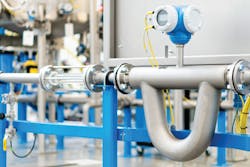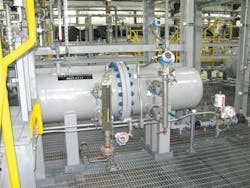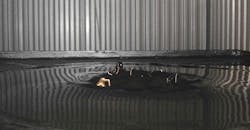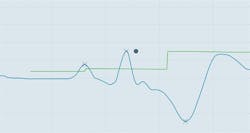Solving difficult level and flow measurement problems in crude oil production processes
Current low prices of crude oil have reduced the profitability of exploration and production operations. Employing new and improved measurement technologies can lower operating costs by improving efficiency. This article discusses how modern instrumentation solves problems with measuring level and flow in crude oil separators.
Measuring flow
Flow measurements in a separation process must accommodate crude oil, condensates, produced water and natural or associated gas. Coriolis mass flowmeters have been replacing traditional meters (positive displacement, turbine and differential pressure flowmeters) because of their robustness, accuracy and immunity to wear and tear.
In the hydrocarbon leg of the separator, Coriolis flowmeters are replacing traditional mechanical type flowmeters due to the lack of moving parts and reduced maintenance needs. They are also advantageous because they can provide multiple parameters including flow, density and temperature. One Coriolis flowmeter (see Image 1) includes a petroleum package with options for net oil, API gross and net volume calculations, viscosity and Reynolds number trending. These features allow operators to have a better understanding of the quality of oil out of the separator and can help improve separator efficiencies and allow for improved allocation to royalty owners.
The flowmeter also employs multifrequency technology whereby the flow sensor drives the oscillating tube with different frequencies to suppress the error associated with suspended bubbles in a liquid stream.
Produced water is highly conductive, thus an electromagnetic flowmeter is one of the most popular approaches for measuring its flow. For high-pressure separators, the rock particles and sand that wear the meter liner can be a pain point. Coriolis flowmeters have also proven to be successful and cost-effective in these applications, although more expensive.
Natural gas flow measurements complete the third dynamic measurement required in a separator (see Image 2), and vortex and Coriolis flowmeters are typically used to make these measurements.
A Coriolis meter for natural gas measurement, supported by American Gas Association (AGA) Report No. 11, represents a straightforward and consistent approach that simplifies the meter installation since no straight-run lengths are required. Because of pressure loss and diameter reduction considerations, Coriolis meters are recommended only up to 10 inches, which is the regular gas pipe diameter range in separators.
A West Texas exploration and production company was having problems dealing with modern crude oil process conditions. The oil leg flow measurement, which was being made with turbine flowmeters, was consistently a problem. These turbine flowmeters were upgraded to Endress+Hauser Promass Coriolis flowmeters.
Image 3. In a crude oil separator, oil floats to the top and water is removed from the bottom. Measuring the oil/water interface is critical to keep oil from being sent to the water processing system.
A 2-inch Coriolis meter was installed to not only provide a consistent mass flow measurement, but also to monitor the crude oil density correlated to the presence of water in the flow stream. This allocation measurement was improved to monitor the presence of water using the water-cut function of the meter.
The results encouraged the customer to extend the use of Coriolis flowmeters in vertical separators.
Vortex flowmeters fulfill and surpass the natural gas flow measurement requirements in separators related to accuracy, repeatability and turndown ratio. Modern vortex meters have additional features.
A built-in flow computer with AGA-8 and AGANX- 19 capabilities means no additional calculations need to be done in a separate flow computer. Another feature is inlet run compensation, which radically reduces the requirement for straight-run diameters upstream and downstream from the meter.
Emulsions prove troubling for interface control
An oil field exploration company was having issues with a standard guided wave radar device installed in a separator to measure overall and interface level. An emulsion layer — also called a rag layer — is an area where two liquid products, such as oil and water, have not fully separated. The thicker this layer becomes, the more challenging it can be to measure the true interface level.
A separator removes water from crude oil. The oil floats on top (see Image 3), while water is removed from the bottom of the tank and sent to a water processing plant. It is important to know the exact level of water in the separator to prevent oil being sent to the water processing plant, and water being sent with the oil for further processing. An emulsion layer between the oil and water interferes with this level measurement.
Figure 1. When an emulsion is present, a guided wave radar level instrument can locate the oil/water interface layer (black dot). The green line is the preset threshold based on the initial setup of dielectric constant.
With guided wave radar level measurement instruments, the microwave pulse emitted from the transmitter gets reflected at the top layer of oil, thus measuring overall level. Part of the pulse continues through the oil to the oil/water interface, where a second reflection is created, which can be used to measure the interface level (see Figure 1 on page 24).
However, if an emulsion layer of more than 2 inches exists, then the guided wave radar will not work reliably because the reflection from the oil/water interface is greatly decreased. Guided wave radar technologies are best suited for clean interface level applications and for applications where very little or no emulsion/rag layers are present. To address this guided wave radar limitation, a dual-technology measurement device combining capacitance and guided wave radar was installed in this application.
Capacitance level measurement is based on the change in capacitance in a vessel, normally due to the change in the level of the liquid. As long as one product is conductive and the other is nonconductive, as with oil and water, a reliable interface measurement can be obtained. Therefore, when dealing with oil/ water emulsion layers, capacitance technology is the preferred technology.
Figure 2. When an emulsion layer is present, the reflection can be too weak (below the green dielectric threshold line) to detect with guided wave radar. In this case (black dot), Endress+Hauser’s FMP55 uses its capacitance sensor to measure the oil/water interface.
A dual-fusion sensor combines guided wave radar and capacitance sensing technology. This type sensor was installed in the separator and immediately delivered positive results.
Figure 1 shows how the transmitter measures level with its guided wave sensor with no emulsion layer present. In this case, the transmitter can calculate the oil/water interface level because it gets a strong signal from the interface. Figure 2 shows how the same transmitter automatically uses its capacitance sensor when a thick emulsion layer is present.
So, whether there is a clean interface or an emulsion layer, the transmitter reliably measures both the overall and interface level, providing the measurement information required to accurately separate the oil from water, maximizing crude oil production.
The transmitter was installed approximately 4 inches upstream of the weir plate directly in the separator. Traditionally, this interface is measured outside the separator in a bridle. This has been the only way to measure in the past, but the emulsion present in the separator typically does not repeat in a bridle, thus resulting in an inaccurate measurement.
Unreliable interface measurement in the separator causes poor control of the dump valve, which can cause additional problems downstream of the separator. Problems include poor results in crude and water quality, ultimately impacting the allocation. The transmitter can be used with a coax probe and be installed directly in the separator. This allows the interface level to be set for the optimum position to ensure only oil was flowing over the weir. The maximum amount of oil was captured as the amount of oil in the water was reduced. Another transmitter was installed downstream of the weir plate to monitor the oil level in the oil collection area.
The oil field exploration company now has a reliable interface measurement at all times, even with the formation of a thick emulsion layer, and the efficiency of the separator was increased. This provides better oil recovery without getting water into the oil, or oil into the water. There are currently more than 500 of these transmitter devices installed in the Delaware Basin of West Texas at one company alone.
Summary
Oil producers often deal with troublesome applications including water carryover into the oil leg of separators, entrained gas in oil and water legs, emulsion layers inside the separator, varying densities and remote areas. These concerns can be difficult for traditional instrumentation to measure, but modern level and flow instruments have been developed to successfully address these issues.
Mark Thomas is the U.S. Industry Manager for Oil and Gas at Endress+Hauser. Prior to his current role, Thomas was a national strategic account manager for a major oil and gas company and has spent his entire career supporting the oil, gas, refining and petrochemical industries. He is a graduate of Texas Tech University.








